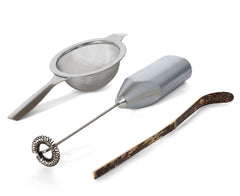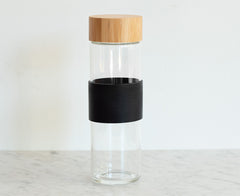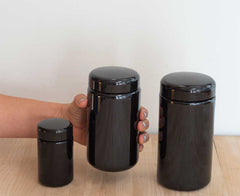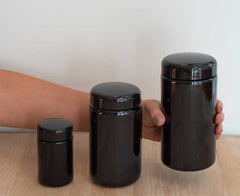Matcha has been around a long time — since the late 12th century in Japan, a good 300 years before the printing press was invented, and centuries before Copernicus, Michelangelo, and da Vinci were born. But its origins go back even further, to 8th-century China, when it was thought of more as a an art form, akin to poetry, with which one amused oneself, than as a daily beverage.
Chinese zen (chan) monks were the ones who discovered the joys of pulverizing green tea leaves (which had first been steamed, then dried, then packed into tight molds for easy portability). They would prepare their tea by breaking off a chunk, mashing it with a mortar and pestle until they got a fine powder, and then whisking the tea powder and hot water together in a wide, shallow bowl. Preparation and consumption of this tea played an important part in the lives of lots of early Zen Buddhists, and, eventually, elaborate rituals were formed around this idiosyncratic green tea.
An influential Japanese Buddhist monk (in the Tendai sect) by the name of Eisai Myoan, on a trip to China in the late 1180s, became rather smitten with two important Chinese practices: Zen Buddhism and matcha. He came back to Japan pretty fired up about both, and devoted the rest of his life to writing about and teaching both zen and matcha.
Matcha fell from favor among Chinese intellectuals — it’s never been quite clear why — and was slowly replaced by other forms of Chinese tea (especially pu-ehr), but its popularity only grew in Japan, thanks initially to Eisai’s incessant efforts (his two-volume Kissa Yojouki (“Book of Tea and Mulberries” has been a classic ever since).
It’s rare that a single non-political individual could influence the culture of a civilization to the extent that Eisai did, but he really hit one out of the park as a result of that trip to China: zen buddhism and matcha have been integral, and complementary, to Japanese culture and history for almost a millennium.
Zen monasteries in Japan took to matcha quickly. They favored matcha for a few reasons: 1) it kept them awake and alert during long periods of meditation, and 2) they knew it had valuable medicinal properties that we now have a very scientific handle on (see The Health Benefits of Matcha).
Matcha soon became appreciated by the higher strata in Japan’s caste-oriented early society, especially among the samurai class, and it grew in popularity through the end of the 16th century. It was during this time that tea growers, mostly in Uji, Kyoto, really began to understand the best cultivation techniques. With time, they kept learning about and producing better matcha.
Consuming and appreciating matcha, in addition to simultaneous pursuit of Japan’s other traditional arts like poetry, flower arrangement, and painting, gave one a kind of cultural clout; fluency in matcha was considered a good way to “rise above one’s station” in life. People aspired to matcha. Feudal politicos/bosses (known as daimyo) retained tea masters on their payrolls for the prestige they brought, and collected tea paraphernalia like ceramics and utensils, which were considered prized cultural possessions.
Somehow along the way, then, the use and enjoyment of matcha in China waned, but it was transmitted to Japan, where it developed independently, at first in zen monasteries, and then on to the general public in the form of chanoyu, or the tea ceremony. Tea rules emerged from the many rules that tightly govern daily life in zen temple.
By the 16th century, professional tea masters, such as Sen No Rikyu, developed the tea ceremony into a highly choreographed ritual that makes use of many art forms, including ceramics, painting, lacquerware, culinary arts, architecture and design, calligraphy, flower arrangement, and even gardening. It’s hard to think of another pursuit that draws on so many disparate artistic pursuits.
The enjoyment of matcha was at first practiced exclusively by men (monks and influential leaders, mostly), but, over time, women became increasingly involved. Today, women far outnumber number men in the pursuit of chanoyu.
The good news is that, today, the popularity of matcha has never been greater or more widespread, far more so than it was during the period of its heyday in the Edo Period and prior to that.
Our belief is that, once matcha becomes increasingly disconnected to chanoyu and is enjoyed on its own — perhaps with a small, personal ceremony of one’s own — its popularity will skyrocket.




